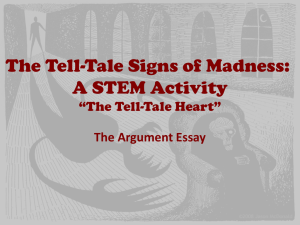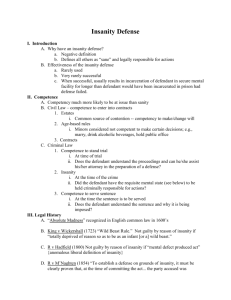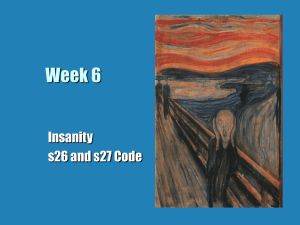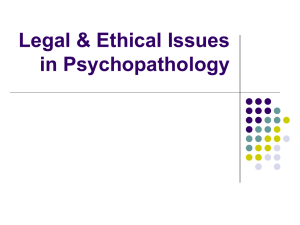Jennings 2013 - Open access journal of forensic psychology
advertisement
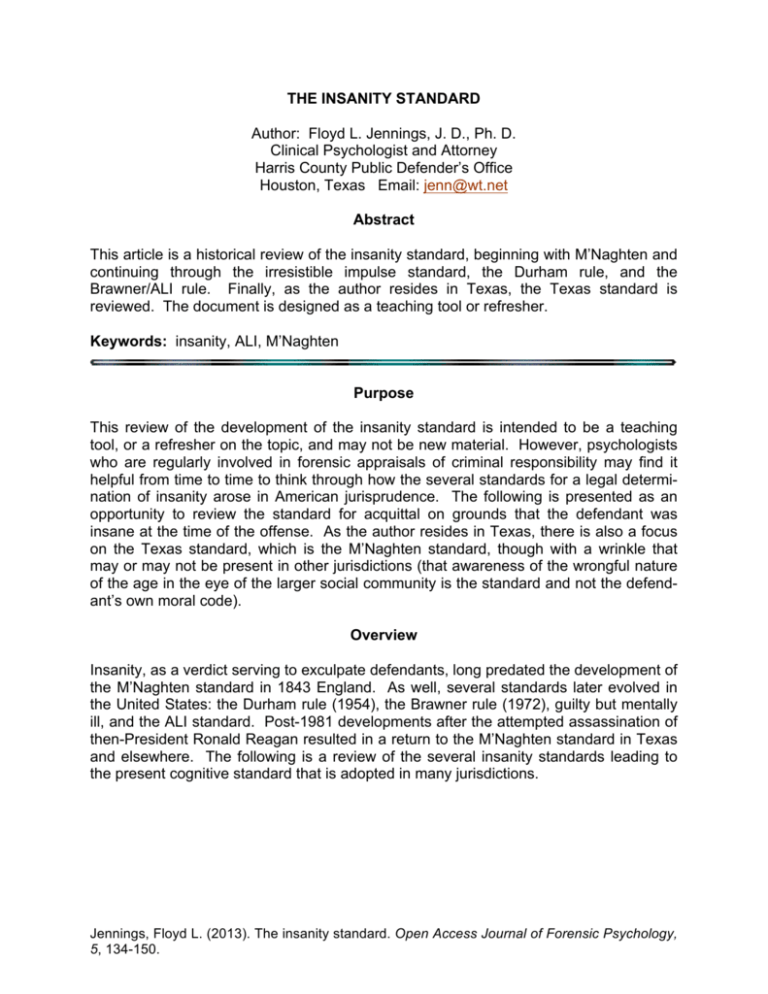
THE INSANITY STANDARD Author: Floyd L. Jennings, J. D., Ph. D. Clinical Psychologist and Attorney Harris County Public Defender’s Office Houston, Texas Email: jenn@wt.net Abstract This article is a historical review of the insanity standard, beginning with M’Naghten and continuing through the irresistible impulse standard, the Durham rule, and the Brawner/ALI rule. Finally, as the author resides in Texas, the Texas standard is reviewed. The document is designed as a teaching tool or refresher. Keywords: insanity, ALI, M’Naghten Purpose This review of the development of the insanity standard is intended to be a teaching tool, or a refresher on the topic, and may not be new material. However, psychologists who are regularly involved in forensic appraisals of criminal responsibility may find it helpful from time to time to think through how the several standards for a legal determination of insanity arose in American jurisprudence. The following is presented as an opportunity to review the standard for acquittal on grounds that the defendant was insane at the time of the offense. As the author resides in Texas, there is also a focus on the Texas standard, which is the M’Naghten standard, though with a wrinkle that may or may not be present in other jurisdictions (that awareness of the wrongful nature of the age in the eye of the larger social community is the standard and not the defendant’s own moral code). Overview Insanity, as a verdict serving to exculpate defendants, long predated the development of the M’Naghten standard in 1843 England. As well, several standards later evolved in the United States: the Durham rule (1954), the Brawner rule (1972), guilty but mentally ill, and the ALI standard. Post-1981 developments after the attempted assassination of then-President Ronald Reagan resulted in a return to the M’Naghten standard in Texas and elsewhere. The following is a review of the several insanity standards leading to the present cognitive standard that is adopted in many jurisdictions. Jennings, Floyd L. (2013). The insanity standard. Open Access Journal of Forensic Psychology, 5, 134-150. The Insanity Standard 135 History of the insanity standard Pre-M’Naghten Aristotle (384 BC – 322 BC) wrote in Ethics, Book 3, in discussing virtue, that culpability for criminal acts was to be predicated upon intention (volition) and knowledge, such that an act committed without intent or without knowledge was not an act deserving punishment. More than 2000 years later, English common law recognized that a defendant was to be exculpated because of insanity. In Rex v. Arnold (1724) 16 How St. Tr. 765 (sometimes cited as 16 St. Tr. 704), Arnold shot and wounded Lord Onslow. He was sentenced to death but Lord Onslow secured a reprieve to life in prison. Lord Tracey recognized the “wild beast” standard: A man must be totally deprived of his understanding and memory, so as not to know what he is doing, no more than an infant, a brute, or a wild beast, such a one is never the object of punishment. Note, however, that this case report was in written in Latin and the term “wild beast” meant farm animals, as well as deer, or rabbits. Nevertheless, the insanity defense in the 18th century was based upon lack of cognition, which would otherwise establish culpability. There followed a series of cases. In Rex v. Ferrers, (1760) 19 How St. Tr 886, the defendant was pro se, but 117 Lords of the House of Lords rejected the “irresistible impulse” standard. In Rex v. Hadfield (1800), 27 How St. Tr. 1282, Lord Erskine defended Hadfield, a disabled veteran who had brain damage and who was also reportedly delusional, believing he should be put to death by the State, like Christ, to save the world. He shot at King George III, which was a capital crime. Lord Erskine convinced the court to overthrow the “wild beast” test and view insanity as the “product of delusion.” The defendant was found not guilty and committed to Bedlam. The M’Naghten standard It was a foggy day in London town on Friday, the 20th of January, 1843.1 In the late afternoon, the soot from coal fires used for heating combined with the mist to cast a dark pall over the city such that by four o’clock in the afternoon it was dark (though the sun set at roughly 4:15-4:30 p.m.). The first gas streetlights had appeared in London in 1807, and by the 1840’s they were common, though casting only a dim light through the 1 Only a week earlier, on 13 January 1843, some of the lowest barometric pressures ever recorded in the United Kingdom were observed, 954.8mb in London at 12:45 p.m., though the temperature on 20 January had risen from a low in the 30s the week prior to the low 40s, and the month was to be warmer than usual. See, for example, the Armagh Meteorological Records, also, Nature, No. 1742, Vol. 67 (March 19, 1903). OAJFP – SSN 1948-5115 – Volume 5. 2013 The Insanity Standard 136 miasmic fog. This was truly Charles Dickens’ London, as he depicted in A Christmas Carol in 1843, and a rather grim place indeed. Shortly after four in the afternoon, a distinguished gentlemen left government buildings, likely the treasury office on Whitehall (which is across St. James park from Buckingham Palace and St. James Palace), though some reports say it was the official residence of the Prime Minister, Sir Robert Peel, in Whitehall Gardens. In any event, he was walking north on Whitehall, past the horse guards parade grounds, toward Charing Cross. He was soon to be shot in the back by Daniel M’Naghten.2 Daniel M’Naghten was a Scottish wood-turner (wood worker) who had persecutory delusions as well as command hallucinations. He believed in a worldwide conspiracy wherein Sir Robert Peel, the prime minister, was seeking to kill him. In fact, M’Naghten had complained to the police on several occasions, seeking protection. He had come to London from Glasgow some months earlier (though he had made a still earlier trip to France). On the afternoon of January 20, 1843, M’Naghten was standing near the location described, and had intended to shoot the prime minister, Sir Robert Peel. However, M’Naghten mistook the PM’s personal secretary/chief of staff, Edward Drummond, for the prime minister and shot him point blank in the back. A police officer standing literally a few feet away took M’Naghten into custody before he could discharge a second weapon he had on his person. Drummond had sufficient strength to stagger a short distance to the townhome of his brother-in-law, where he languished for five days, dying either of sepsis or due to the medical practice of leeching. When arrested, M’Naghten had on his person a bank receipt for £745—as much as $100,000 in today’s currency. How he had access to such a large sum was never discussed in trial or subsequent proceedings (though conspiracy theorists could argue that M’Naghten was part of a larger movement against the Prime Minister and government). M’Naghten was charged and his defense was orchestrated by his father who applied to the court to have the funds released to pay for his defense. The trial was held slightly over a month later on March 2-3, 1843, and M’Naghten was defended by a well-known attorney, Alexander Cockburn. Several medical witnesses testified that his delusions had served to relieve him of “all restraint over his actions.” M’Naghten testified at his arraignment that: ‘The Tories in my native city have compelled me to do this. They follow me and persecute me wherever I go, and have entirely destroyed my peace of mind. They followed me into France, to Scotland all over England. They have accused me of crimes of which I am not guilty; they do everything in their power to harass and persecute me; in fact, they wish to 2 J. Thomas Dalby The Case of Daniel McNaughton: Let’s get the story straight, Am. J. Psychiatry, vol 27, 2, (2006) presents an alternative, well-researched and cogent account of the case, arguing that Drummond was not walking out of the government buildings but was returning from Drummond Bank on Downing Street, having left his offices earlier, gone to the family bank in Charing Cross and was now returning. Moreover, Dalby argues that the evidence that M’Naghten (different spellings appear in different documents, often even the same) intended to shoot the prime minister is scanty. The assailant evidently reported that Drummond was part of the “crew” that had been following him. OAJFP – SSN 1948-5115 – Volume 5. 2013 The Insanity Standard 137 murder me. It can be proved by evidence. That is all I have to say.’3 At trial, the defense had several medical witnesses and the prosecution had no rebuttal witnesses; and, in fact, the prosecutor said in his closing statement, ‘I cannot press for a verdict against the prisoner.’ Chief Justice Tindal, in his charge to the jury, reminded them that, if they found the prisoner not guilty on the ground of insanity, he would receive treatment. The jury did not retire to deliberate and essentially immediately returned a verdict of not guilty by reason of insanity. 4 St. Tr. (N.S.) 847. M’Naghten was hospitalized in Bethlehem, known as “Bedlam,” and transferred to Broadmoor in 1863, where he died in 1865.4 Subsequent to the trial, there was much hue and cry in England concerning M’Naghten’s acquittal. Queen Victoria had become Queen in 1837, at age 18. She married in 18405 and was the object of an assassination attempt in that year. A second attempt occurred in 1842.6 Because of the shooting of Drummond, she was distressed about M’Naghten’s acquittal and requested that the case be reviewed by the House of Lords. That body then called on twelve judges of the common law courts, including Lord Chief Justice Tindal, to answer a series of questions regarding the law of insanity. The comments of those judges became the basis of modern law. Thus, Daniel’s case (1843) 10 Cl. & F. 200 was not the legal decision of the M’Naghten case, but a statement of the views of judges who, incidentally, protested as to the inconvenience of being called upon to express their opinions in the abstract and not in relation to the facts of a particular case and without argument or debate of the matter, per C. J. Kennedy, delivering the judgment of the Court of Criminal Appeal in Attorney General v. O’Brien (1936) I.R. 263. The rules stated by the judges in the M’Naghten case were as follow: 1. 2. 3. Persons acting under the influence of an insane delusion are punishable if they knew at the time of committing the crime that they were acting contrary to law. Every man is presumed sane and to have sufficient reason to be held responsible for his crimes. To establish a defense on the ground of insanity it must be clearly proved that, at the time of committing the act, the accused was laboring under 3 R Moran Knowing Right from Wrong: The insanity defense of Daniel McNaughten. The Free Press, New York, 1981. 4 See, Jacques M. Quen, An Historical View of the M’Naghten Trial, Bulletin of the History of Medicine, 1968, 42:43-51. 5 Edward Oxford was the assailant, discharging two weapons before being restrained by passers-by. He was acquitted not guilty by reason of insanity and several years later released from Broadmoor, residing in Australia, and died in 1900. See: Charles, Barrie (2012). Kill the Queen! The Eight Assassination Attempts on Queen Victoria, Amberley Publishing, ISBN 978-1-4456-0457-2 6 John Francis shot at the Queen while she was riding in a carriage. He was convicted and given the death penalty, which was commuted to “transportation for life,” i.e. being sent to Australia, a penal colony. There were several other attempts on the Queen in later periods. OAJFP – SSN 1948-5115 – Volume 5. 2013 The Insanity Standard 4. 5. 138 such a defect of reason, from disease of the mind, as not to know the nature and quality of the act he was doing, or, if he did know it, that he did not know he was doing what was wrong. If the accused was conscious that the act was one that he ought not to do, and if the act was at the same time contrary to the law of the land, he is punishable. A person under a partial delusion is to be considered as if the facts with respect to which the delusion exists were real. This standard, with minor modifications, was to survive as the principal standard upon which most American jurisdictions rely. Irresistible impulse test Nonetheless, only a year after the M’Naghten case, a different standard was introduced in America: the irresistible impulse test. In Commonwealth v. Rodgers, 7 Metcalf 500 (Mass. 1844), the court held: ‘If then it is proved, to the satisfaction of the jury, that the mind of the accused was in a diseased and unsound state, the question will be, whether the disease existed to so high a degree, that for the time being it overwhelmed the reason, conscience, and judgment, and whether the prisoner…acted from an irresistible and uncontrollable impulse. If so, then the act was not the act of a voluntary agent, but the involuntary act of the body without the concurrence of a mind directing it.’ Commonwealth v. Rodgers, p.502. Some 85 years later, in 1929, the D. C. Circuit adopted the irresistible impulse standard not as the primary standard, but as supplementary, in Smith v. U.S., 36 F.2d 548 (D. C. Cir. 1929). See below (italics mine): The modern doctrine is that the degree of insanity which will relieve the accused of the consequences of a criminal act must be such as to create in his mind an uncontrollable impulse to commit the offense charged. This impulse must be such as to override the reason and judgment and obliterate the sense of right and wrong to the extent that the accused is deprived of the power to choose between right and wrong. The mere ability to distinguish right from wrong is no longer the correct test either in civil or criminal cases, where the defense of insanity is interposed. The accepted rule in this day and age, with the great advancement in medical science as an enlightening influence on this subject, is that the accused must be capable, not only of distinguishing between right and wrong, but that he was not impelled to do the act by an irresistible impulse, which means before it will justify a verdict of acquittal that his reasoning powers were so far dethroned by his diseased mental condition as to deprive him OAJFP – SSN 1948-5115 – Volume 5. 2013 The Insanity Standard 139 of the will power to resist the insane impulse to perpetrate the deed, though knowing it to be wrong. This standard is a kind of duress standard, also adopted briefly in some states in the 19th century, and used (successfully) in the Lorena Bobbitt trial in 1994. It was, however, not widely adopted. The D. C. Circuit was to regard it as too narrow, i.e. dependent solely on near instantaneous impulses. In Sollars v. State, 316 P.2d 917 (Nev. 1957) the court criticized this standard as having little acceptance by the mental-health community, as “the will and intellect cannot easily be separated one from the other.” Spurlock v. State, 368 S.W.2d 299 (Tenn.1963). The Spurlock court agreed with Durham, which preceded it, (Durham v. United States, 214 F.2d 862 [D. C. Cir. 1954]) that the irresistible impulse standard “offered insufficient criteria.” Even as early as 1912, in State v. Riddle, 150 S.W. 1044 (Mo. 1912), Missouri repudiated the irresistible impulse test (before its adoption in the D. C. Circuit). The Durham Standard The Durham standard came into existence in 1954, in Durham v. United States, 214 F.2d 862 (D. C. Cir. 1954) through the opinion of Judge Bazelon. Judge David L. Bazelon, appointed in 1949, served on the D. C. Circuit until 1979 (and in semi-retirement thereafter). In Durham, he broadened the M’Naghten rule to state: “an accused is not criminally responsible if his unlawful act was the product of mental disease or defect.” (Although it is often said that the Durham standard is the same as the New Hampshire standard in State v. Pike, [N. H. 1870], that is not accurate.)7 Monty Durham was arrested in the District of Columbia in 1951 on a “house breaking” charge. He was then 26 years of age. • In 1945 at the age of 17, he was discharged from the Navy as unfit for military service, suffering from a “profound personality disorder.” • In 1947, he pled out to three years’ probation on an auto-theft case. • Shortly thereafter he attempted suicide and was hospitalized at St. Elizabeth’s for three months. 7 See discussion in John Reid, Understanding the New Hampshire Doctrine of Criminal Insanity, 69 Yale L.J. 367, 381 (1960). The New Hampshire doctrine asserts more than that the act must be the product of mental illness. Rather it requires that the “disease is of such a character, or was (it) so far developed, or had it so subjugated the powers of mind, as to take away the capacity for form or entertain a criminal intent.” It appears there is no mens rea, because of the mental illness. Reid, in a convoluted argument says that mens rea remains, though Henry Weihofen in Mental Disorder as a Criminal Disease (1954) had firmly argued that the New Hampshire standard rests “upon the fundamental principle that criminal responsibility requires a guilty intent, or mens rea, as well as a prohibited act”; and the New Hampshire standard essentially removes the mens rea. In addition, and in contrast to the common standard used in many jurisdictions, New Hampshire sees insanity not as a mixed term of law and fact, but solely as an issue of fact—an evidentiary issue—to be determined by a jury. New Hampshire judges have refused to establish a definition of “mental disease.” OAJFP – SSN 1948-5115 – Volume 5. 2013 The Insanity Standard 140 • In 1948, he had some bad checks, and the probation on the unauthorized use of a motor vehicle case was revoked, but he became psychotic in jail and was again sent to St. Elizabeth’s suffering from “psychosis with psychopathic personality.” He remained for 15 months and was discharged in 1949, returning to jail. • In June 1950, he was released but violated conditions by leaving the District. He fled to the South and Midwest, passing bad checks and was returned to D. C. where he was again found to be of “unsound mind,” whether incompetent by modern standards or simply insane is not clear. But he returned to St. Elizabeth’s in February 1951 and remained until May 1951, though the diagnosis was “without mental disorder, psychopathic personality.” • He was rearrested on July 13, 1951, re-committed to St. Elizabeth’s and released in February 1953 as “mentally competent to stand trial.” The court undertook a critique of the essentially cognitive, or knowledge-based, test for insanity and then suggested that the irresistible impulse test was also flawed in that there was a presumption of near instantaneous and overwhelming impulses to commit an act. Whereas, the nature of mental illness is such that the act may be calculated and “yet the act of a madman.” We find that the ‘irresistible impulse’ test is also inadequate in that it gives no recognition to mental illness characterized by brooding and reflection and so relegates acts caused by such illness to the application of the inadequate right-wrong test. We conclude that a broader test should be adopted. The court then added that, “The rule we now hold must be applied on the retrial of this case and in future cases is not unlike that followed by the New Hampshire court since 1870. It is simply that an accused is not criminally responsible if his unlawful act was the product of mental disease or mental defect.” The reference to New Hampshire may be in error, but the rule relating to insanity as a product of mental disease or defect is clear. The Durham rule was designed to (1) broaden the scope of the then-existing test of insanity, (2) strengthen the role of the expert witness in criminal proceedings, and (3) allow consideration of more than cognitive factors to include instantaneous but irresistible impulses.8 In short, if the M’Naghten standard was a knowledge standard, the Durham rule is a volitional standard, where volition is impaired. Subsequently, however, problems arose in the definition of “mental disease” and because of the vagaries of mental-health diagnoses, experts frequently disagreed. In addition, the Durham standard was criticized for being far too broad.9 But, also, 8 For a discussion see, Samuel Jan Brakel & Alexander D. Brooks (2001), Law and Psychiatry in the Criminal Justice System, New York: Williams S. Hein & Co. 9 Kwosek v. State, 100 N.W.2d 339 (Wisc. 1960); Kahan, Dan M. and Nussbaum, Martha C., Two Conceptions of Emotion in Criminal Law, 96 Colum. L. Rev. 269 (1996). OAJFP – SSN 1948-5115 – Volume 5. 2013 The Insanity Standard 141 experts, not fully appreciating the new standard, offered opinions on the ultimate issue without providing specific linkages of the diagnosis or diagnoses to the criminal act.10 Brawner/ALI rule Some eighteen years after the Durham decision, in 1972, the Brawner rule appeared in United States v. Brawner, 471 F.2d 969 (D. C. Cir. 1972). In September of 1967, Archie Brawner was at a party in which there were fights and he was injured in the jaw during one of those altercations. The opinion indicates that he left about 10:30 p.m., returned a half hour later with a firearm, discharged one round into the ground outside, and then went to the closed apartment door, discharging five rounds through the door, striking one Billy Ford, resulting in Mr. Ford’s death. Upon evaluation, Mr. Brawner was variously seen to exhibit "epileptic personality disorder," "psychologic brain syndrome associated with a convulsive disorder," "personality disorder associated with epilepsy," or, more simply, "an explosive personality." All agreed that his condition was exacerbated by the use of alcohol. There was further agreement that the defendant had a mental condition as well as a clearly neurological condition (though in the modern world virtually all mental conditions are seen as having a biological basis). As might be expected, the experts disagreed, some saying he was simply angry (and intoxicated) on the night in question (which would likely have led to a guilty verdict in states where voluntary intoxication is no defense). Other experts said there was a causal link between his mental-health condition and the criminal act, about which there was no doubt he had committed. The court proceeded to trace the development of the irresistible impulse test and the Durham test, noting that the latter gave rise to the possibility of “trial by label” (if the act was the product of “mental disease or defect”). Not only was there difference, namely, what was or was not a “mental disease,” but the question of what constituted a “product” of the mental disease was often not well explicated; or the mere presence of the condition presumed the product. The court noted that the Durham rule was supplemented in Carter v. United States, 102 U.S.App.D. C. 227 at 234, 235, 252 F.2d 608 at 615-616 (1957): The simple fact that a person has a mental disease or defect is not enough to relieve him of responsibility for a crime. There must be a relationship between the disease and the criminal act; and the relationship must be such as to justify a reasonable inference that the act would not have been committed if the person had not been suffering from the disease. 10 Roesch, R., Zapf, P., Hart, S. (2010) Forensic Psychology and Law, p.40. Hoboken, NJ: John Wiley & Sons. OAJFP – SSN 1948-5115 – Volume 5. 2013 The Insanity Standard 142 The difficulties in this period also led to the federal rule prohibiting experts from commenting on the ultimate issue. Ultimately, the Brawner court was to adopt the definition propounded in the American Legal Institute’s Model Penal Code, i.e. the ALI standard: A person is not responsible for criminal conduct if at the time of such conduct as a result of mental disease or defect he lacks substantial capacity either to appreciate the criminality [wrongfulness] of his conduct or to conform his conduct to the requirements of the law.11 The ALI standard, therefore, has three prongs: the presence of “mental disease or defect,” such that the actor lacks “substantial capacity to appreciate the criminality [wrongfulness] of his conduct, or, is (as a result of the mental disease or defect) unable to confirm his conduct to the requirements of the law. The American Legal Institute began studying the issue of criminal responsibility in 1953 and the Model Penal Code was finally adopted in 1962. It became the more commonly used standard throughout the country until the John Hinckley trial in 1982. After his attempted assassination of then-President Reagan in 1981, and subsequent acquittal on grounds of “not guilty by reason of insanity,” numerous states changed the insanity standard, dropping the “unable-to-conform” prong. Insanity Defense and Reform Act (IDRA) In 1984, partially in response to the Hinckley assassination attempt, the United States Congress passed the Insanity Defense and Reform Act12 addressing the following issues: • Affirmative defense: establishing that insanity is an affirmative defense under any Federal Statute, such that at the time of the commission of the acts constituting the offense, the defendant as a result of a severe mental disease or defect, was unable to appreciate the nature and quality or the wrongfulness of his acts. • Burden of proof: the defendant has the burden of proof. • Standard of evidence: the standard of evidence is clear and convincing. This act reduced the volitional prong of the ALI standard and was instrumental in prompting similar changes in many states. Essentially, the 1984 Insanity Defense and Reform Act brought the courts on the federal level, and as adopted in many states, back to the M’Naghten rule. 11 12 American Legal Institute (1962). Model Penal Code. Philadelphia, PA. Pub. L. No. 98-473, secs. 401-06, 98 Stat. 2057-70 (1984). For a discussion see United States v. th Owens, 854 F.2d 432 (11 Cir. 1988). OAJFP – SSN 1948-5115 – Volume 5. 2013 The Insanity Standard 143 Guilty but mentally ill Several states have also adopted a “guilty but mentally ill” standard. States allowing, if not requiring, the GBMI standard include: Alaska (allowing) Arizona (allowing) Delaware (allowing) Georgia (allowing) Illinois (allowing) Indiana (allowing) Kentucky (allowing) Michigan (allowing) Montana (abolished NGRI, GBMI permitted) New Mexico (allowing) Pennsylvania (allowing) South Carolina (allowing) South Dakota (allowing) Utah (abolished NGRI, GBMI permitted) GBMI means a substantial disorder, significantly impairing judgment, the capacity to recognize reality, or the ability to cope with ordinary demands of life. GBMI defendants suffer the same sentence as persons conventionally convicted but the place of confinement may be a mental facility. Texas Standard The author resides in Texas and will review the Texas standard as illustrative of a M’Naghten standard rather narrowly applied. Texas has had its share of NGRI cases, although few persons are adjudicated NGRI: In FY-09, some 900,000 cases were disposed of in Texas, and according to the Department of State Health Services (DSHS), only 156 were committed to a state hospital post acquittal as required by statute for any offense involving “dangerous conduct.”13 The actual data is difficult to obtain regularly as the Office of Court Administration for the state does not solicit or maintain this information. Suffice it to say that NGRI acquittals are infrequent events. The Standard The Texas standard (for adults) is codified in Tex. Penal Code §8.01: It is an affirmative defense to prosecution that, at the time of the conduct charged, the actor, as a result of severe mental disease or defect, did not know that his conduct was wrong. 13 Tex. Code Crim. Proc. art. 46C.157ff. OAJFP – SSN 1948-5115 – Volume 5. 2013 The Insanity Standard 144 Note that the juvenile standard is in Tex. Family Code §55.51, and refers to “lack of responsibility for conduct.” It incorporates the ALI standard, including the “inability-toconform prong” eliminated from the adult standard. Sec. 55.51. LACK OF RESPONSIBILITY FOR CONDUCT DETERMINATION; EXAMINATION. (a) A child alleged by petition to have engaged in delinquent conduct or conduct indicating a need for supervision is not responsible for the conduct if at the time of the conduct, as a result of mental illness or mental retardation, the child lacks substantial capacity either to appreciate the wrongfulness of the child's conduct or to conform the child's conduct to the requirements of law. The adult standard, however, trades solely on awareness of wrong. The controlling case is Bigby v. State, 892 S.W.2d 864 (Tex. Crim. App. 1994). Bigby killed his friend and his friend’s sixteen-month-old son in 1987. Bigby believed that his friend was conspiring against him and trying to discredit him in relation to a suit, which Bigby had against his employer, or former employer, Frito Lay. There was no disagreement that the defendant was floridly psychotic and driven by a delusion. He had had psychiatric hospitalizations and was diagnosed as exhibiting a schizoaffective disorder. However, it was argued by some experts that, by his own moral code, his actions were proper. The court concluded that the measure of wrongfulness is not the moral code of the defendant, but the actor’s awareness of the larger social community’s standards. Is the defendant aware that society would regard his conduct as wrong? The court stated “This focus upon appellant’s morality is misplaced…by accepting and acknowledging his action was “illegal” by societal standards, he understood that others believed his conduct was wrong.” Ergo he was not insane, though unequivocally mentally ill. The significance of Bigby is substantial inasmuch as even if the term “know his conduct to be wrong” is changed to “appreciate” as in the federal standard, the measure will be the person’s awareness of the standard of the larger social community, not his own. Two additional cases of historical interest include, Holmes v. State, 20 Tex. Ct. App. 110 (1885) which is a sad tale of a man in east Texas who stabbed his sister-in-law, his estranged wife, and another in a deluded state which we would now likely regard as a major depression with psychotic features. The Court of Appeals remanded the case for a new trial without discussion of the issues. As well, in Kiernan v. State, 84 Tex. Crim. 500 (1919) the court remanded a case because the defendant was convicted although the State did not put on any witnesses to rebut the several witnesses who swore the defendant was insane. But an insanity defense, as noted, is rarely successful. OAJFP – SSN 1948-5115 – Volume 5. 2013 The Insanity Standard 145 Texas issues with regard to an insanity defense include the following: Insanity is not a medical issue One of the pivotal cases in Texas jurisprudence concerning the law of insanity was Graham v. State, 566 S.W.2d 941 (Tex. Crim. App. 1978)(en banc). The defendant was undisputedly schizophrenic and initially not competent to stand trial. The applicable standard at the time was the ALI standard. The court noted that a person might, from a medical point of view, be insane “by reason of mental disease” but from a legal aspect, not yet having reached the point where he is “unable to distinguish right from wrong and to know the nature and consequences of his act…” The court stated in language that has often been quoted since: The issue is not strictly medical, and expert witnesses, although capable of giving testimony that may aid the jury in its determination of the ultimate issue, are not capable of dictating determination of that issue. Only the jury can join the non-medical components that must also be considered in deciding the ultimate issue. That ultimate issue of criminal responsibility is beyond the province of expert witnesses. Were it otherwise, the issue would be tried in hospitals rather than the courts. Voluntary intoxication is no defense In Taylor v. State, 856 S.W.2d 459 (Tex. App. – Houston [1st Dist.] 1993), aff’d 885 S.W.2d 154 (Tex. Crim. App. 1994), the defendant pled “not guilty by reason of insanity” after murdering her four-year-old daughter. That the defendant was mentally ill there was no question; however, she had used marijuana extensively, which either contributed to triggering a psychotic episode or to the loosening of her ability to evaluate her actions and/or modulate her behavior. The court emphasized that “voluntary intoxication is no defense to the commission of a crime.” In the Court of Criminal Appeals opinion, the court stated, “for purposes of this section ‘intoxication’ means disturbance of mental or physical capacity resulting from the introduction of any substance into the body….” Id. at 154. The court noted that intoxication might be introduced as a mitigating factor at punishment because of temporary insanity induced by the intoxicating agent. In this case the record did not reflect that the defendant was intoxicated to the point of temporary insanity, yet there was “some evidence” of intoxication that experts testified of the contribution of her marijuana use to her behavior, thus an instruction to the jury on that point was appropriate. This position is statutory in Tex. Penal Code §8.04. • Psychosis does not establish insanity The fundamental feature of this issue is that the mere presence of psychosis does not establish that a person is insane. The State’s expert noted in the Taylor case that, although the defendant exhibited a severe mental defect, she was aware that her OAJFP – SSN 1948-5115 – Volume 5. 2013 The Insanity Standard 146 actions were wrong and, indeed, underwent an internal struggle to rationalize her behavior. The Appellate Court cited the well-known phrase from Graham: “The ultimate issue of criminal responsibility is beyond the province of expert witnesses. Were it not, the issue would be tried in hospitals rather than courts…. In this regard, it is well established that a jury may accept or reject, in whole or in part, the opinion testimony of physicians, and can accept lay testimony over that of experts” Id, at 468. Thus, while psychosis does not establish insanity, it is best thought of as a necessary, but not sufficient condition. To illustrate, mere psychopathy, in the absence of a legitimate psychotic disorder, does not insanity make, see Foucha v. Louisiana, 504 U.S. 71 (1992). Texas codifies this definition in Tex. Penal Code §8.01(b). The term “mental disease or defect” does not include an abnormality manifested only by repeated criminal or otherwise antisocial conduct; in short, an antisocial personality disorder is insufficient. But, take note that “mental disease or defect” would, or could, include conditions not classified in the Tex. Health & Safety Code § 571.003(14) as a “mental illness,” which reads: ‘Mental illness’ means an illness, disease, or condition, other than epilepsy, senility, alcoholism, or mental deficiency, that: (A) substantially impairs a person's thought, perception of reality, emotional process, or judgment; or (B) grossly impairs behavior as demonstrated by recent disturbed behavior. Post-acquittal civil commitment proceedings A person is found “not guilty by reason of insanity” (NGRI) if: • The State establishes beyond a reasonable doubt that the alleged conduct constituting the offense was committed by the defendant. Tex. Crim. Proc. §46C.153(a)(1); and • The defense has established by a preponderance of the evidence that the defendant was insane at the time of the alleged conduct. Id. 46C.153(a)(2). If a defendant is acquitted NGRI, the court must then decide if the act with which the defendant was charged involved conduct that: • caused serious bodily injury to another person; • placed another person in imminent danger of serious bodily injury; or • consisted of a threat of serious bodily injury to another person through the use of a deadly weapon. Id. 46C.157 If the answer to any one of the foregoing is “no,” i.e. no dangerous conduct, then the court must decide if the person remains mentally ill or is a person with mental retardation. If the answer to the second quest is “yes,” then the person is transferred to the OAJFP – SSN 1948-5115 – Volume 5. 2013 The Insanity Standard 147 civil court having mental-health jurisdiction for further proceedings consistent with such a determination. Id. 46C. Subchapter E. Essentially, if the matter does not involve dangerous conduct the criminal court relinquishes jurisdiction. And, if the person is nondangerous but no longer mentally ill, or a person with mental retardation, then the person is to be discharged. On the other hand, in the circumstance wherein the person is found to have engaged in dangerous conduct, and there is present evidence either of mental illness or mental retardation, the criminal court retains jurisdiction for all subsequent civil mental-health proceedings which are, in fact, a separate class of civil commitment proceeding (of which there are eight in Texas; i.e. mental illness, mental retardation, substance abuse, communicable disease, sexually violent predator, 46B.102 and 46B.103 civil commitments, and NGRI). Initially there is a mandatory 30-day commitment to a maximum-security facility of the state hospital system,14 followed by evaluation to ascertain if the defendant meets commitment criteria and, if so, a 180-day commitment follows, with a possibility of renewal in one-year increments. Note, however, that the commitment criteria differ from the ordinary civil standard and are whether the person, because of a mental illness, poses a likely danger to others. Oddly, a person could be adjudicated as dangerous to self and committed for related treatment, yet be subject to an outpatient order from a criminal court on the grounds of dangerousness to others! Further discussion of the procedural details of civil mental-health proceedings appertaining to NGRI’s are beyond the scope of this brief article. Conclusions This article has focused upon the history of the development of the insanity standard, beginning with the M’Naghten case in 1843 through to the present, with an eye toward the Texas standard. The current standard in Texas is a return to M’Naghten with an emphasis upon the cognitive features associated with the act with which one is charged, and more particularly, if the defendant was, at the time of the act with which charged, aware that the act was illegal or as the courts have said, “the sort of thing he ought not to do.” Presence of mental disease or defect, while a necessary condition for an NGRI determination, is not sufficient. Conclusions which might follow from this historical review include, but are not limited to: • There is necessity for examiners conducting evaluations of a defendant’s mental state at the time of the offense to become not merely aware of the statutory standard existing in the jurisdiction in which the evaluation is conducted, but case law which may significantly elucidate the standard, some of which may be counter intuitive. 14 Tex. Code Crim. Proc. art. 46B.251(a). OAJFP – SSN 1948-5115 – Volume 5. 2013 The Insanity Standard 148 • While juries may or may not be told of the consequences of an NGRI verdict, examiners would be well advised to be aware of the statutory requirements as may relate to the defendant’s present state of mind, i.e. whether he/she meets criteria for civil commitment at the present moment, as opinions on that issue are likely to be sought. Moreover, the standard for NGRI commitments may differ from that of ordinary civil commitments. For example, in Texas an NGRI commitment is based upon the presence of mental illness and dangerousness to others alone. Dangerousness to self is not the standard; yet the examiner may be asked to offer an opinion on the topic generally. • Finally, because legislatures regularly entertain proposed changes to the law, examiners may well have a significant contribution to make if aware of the literature bearing on the topic, e.g. the difference between “know” and “appreciate,” or issues of risk assessment as related to dangerousness to others. OAJFP – SSN 1948-5115 – Volume 5. 2013 The Insanity Standard 149 Appendix Insanity Standard in 50 States Note: The following is understood to be a general description, as each state may rely upon slight, or sometimes substantial, variations. Readers are encouraged to look carefully at the relevant statute. State Alabama Alaska Arizona Arkansas California Colorado Connecticut Delaware D. C. Florida Georgia Hawaii Idaho Illinois Indiana Iowa Kansas Kentucky Louisiana Maine Maryland Massachusetts Michigan Minnesota Missouri Mississippi Montana Nebraska Nevada Standard M’Naghten – Ala. Code § 13A-3-1 M’Naghten – Alaska Stats. § 12.47.010(a). GBMI permitted (AS 12.47.030) M’Naghten – Ariz. Rev. Stat. § 13-502, Arizona also permits a Guilty but Insane verdict, ALI standard – Ark. Code Ann. § 5-2-312 M’Naghten -- Cal. Penal Code § 25 M’Naghten -- Colo. Rev. Stat. §16-8-101 ALI standard -- Conn. Gen. Stat. § 53-13 M’Naghten – Del. Code Ann. tit. 11 § 401, GBMI verdict permitted M’Naghten – (modified) 18 U.S.C. 17 M’Naghten – (modified) Fla. Stat. § 775.027 M’Naghten – O.C.G.A. § 16-3-2, GBMI permitted in felony cases ALI standard – Haw. Rev. Stat. § 704-400 Abolished insanity defense – GBMI only, Idaho Code § 19-2523 M’Naghten – Ill. Rev. Stat. § 720 5/6-2, GBMI permitted M’Naghten – Ind. Code Ann. § 35-41-3-6 ALI standard, Iowa Code Ann. § 701.4 Abolished insanity defense – Kan. Stat. Ann. § 22-3221, presence of mental state sufficient to exclude mens rea ALI standard, Ky. Stat. Ann. § 504.020, GBMI permitted M’Naghten – La. Rev. Stat. Ann. § 14:14 M’Naghten – modified – 17-A M.R.S.A. § 39 ALI standard – Md. Code Ann. § 3-109 ALI standard – non statutory, see Commonwealth v. McHoul, 226 N.E.2d 556 (Mass. 1967) ALI standard – MCL §768.21a, adds guilty but mentally ill verdict, MCL § 768.36 M’Naghten standard – Minn. Stat. § 611.026 M’Naghten standard – Mo. Rev. Stat. § 552.030 M’Naghten standard – non statutory, see Laney v. State, 486 So.2d 1241 (Miss. 1986) Abolished insanity defense – Mont. Code Ann. § 46-14-101, mental state mitigating at sentencing M’Naghten standard – non statutory, see State v. McGhee, 742 N.W.2d 497 (Neb. 2007) ALI standard & GBMI, Nev. Rev. Stat. Ann. § 174.035 OAJFP – SSN 1948-5115 – Volume 5. 2013 The Insanity Standard New Hampshire New Jersey 150 Wisconsin Insanity may negate mens rea, State v. Shackford, 506 A.2d 315 (N.H. 1986) M’Naghten – modified, N.J. Stat. § 2C:4-1 ALI standard, N.M. U.J.I. Cr. 14-510, with irresistible impulse test permitted, GBMI also permitted M’Naghten – modified, NY CLS Penal § 40.15 M’Naghten, non-statutory, see State v. Linville, 263 S.E.2d 150 (N.C. 1980) ALI standard, modified, N.C. Cent. Code § 12.1-04.1-01 M’Naghten, ORC Ann. 2901.01(14) M’Naghten 21 Okl. St. § 152(4) ALI standard, ORS § 161.295 M’Naghten – modified, 18 Pa.C.S. § 315, GBMI permitted ALI standard, non-statutory, see State v. Johnson, 399 A.2d 469 (R.I. 1979) M’Naghten – modified, S.C. Code Ann. § 17-24-10, GBMI permitted M’Naghten, S.D. Codified Laws § 22-1-2, GBMI permitted M’Naghten, Tenn. Code Ann. § 39-11-501, M’Naghten, Tex. Penal Code § 8.01 Abolished insanity, but permits diminished capacity (negation of mens rea) Utah Code Ann. § 76-2-305 ALI standard, 13 V.S.A. § 4801 M’Naghten, non-statutory, see Price v. Commonwealth, 323 S.E.2d 106 (Va. 1984) M’Naghten, Rev. Code Wash. (ARCW) § 9A.12.010 ALI standard, non-statutory, see State v. Myers, 352 S.E.2d 129 (W.Va. 1986) rev’d on other grounds, State v. Guthrie, 462 S.E.2d 163 (W.Va. 1995) ALI standard, Wis. Stat. § 971.15 Wyoming ALI standard, Wyo. Stat. § 7-11-304 New Mexico New York North Carolina North Dakota Ohio Oklahoma Oregon Pennsylvania Rhode Island South Carolina South Dakota Tennessee Texas Utah Vermont Virginia Washington West Virginia OAJFP – SSN 1948-5115 – Volume 5. 2013
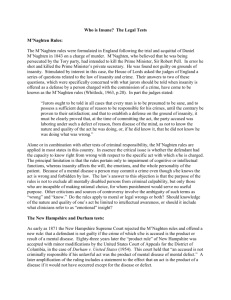
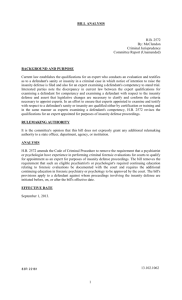


![Legal Phil Unit7[1]](http://s2.studylib.net/store/data/005559584_1-0ae9f41d7c92f7bd9ad93b0a3a74f7d7-300x300.png)
